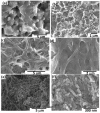Titanium Carbide Nanofibers-Reinforced Aluminum Compacts, a New Strategy to Enhance Mechanical Properties
- PMID: 28773521
- PMCID: PMC5503086
- DOI: 10.3390/ma9050399
Titanium Carbide Nanofibers-Reinforced Aluminum Compacts, a New Strategy to Enhance Mechanical Properties
Abstract
TiC nanofibers reinforced Al matrix composites were produced by High Frequency Induction Heat Sintering (HFIHS).The titanium carbide nanofibers with an average diameter of 90 nm are first prepared by electrospinning technique and high temperature calcination process. A composite solution containing polyacrylonitrile and titanium isopropoxide is first electrospun into the nanofibers, which are subsequently stabilized and then calcined to produce the desired TiC nanofibers. The X-ray diffraction pattern and transmission electron microscopy results show that the main phase of the as-synthesized nanofibers is titanium carbide. The TiC nanofibers is then mixed with the aluminum powders and introduced into high frequency induction heat sintering (HFIHS) to produce composites of TiC nanofibers reinforced aluminum matrix. The potential application of the TiC nanofibers reinforced aluminum matrix composites was systematically investigated. 99.5% relative density and around 85 HV (833 MPa) Vickers hardness of the Al reinforced with 5 wt % TiC nanofiber has been obtained. Furthermore, the sample of Al contains 5 wt % TiC, has the highest value of compression and yield strength of about 415 and 350 MPa, respectively. The ductility of the Al/5 wt % TiC showed increasing with increasing the TiC contents.
Keywords: HFIHS; aluminium composites; nanofibers reienforcemnts; titanium carbide.
Conflict of interest statement
The authors declare no conflict of interest.
Figures
















Similar articles
-
The synthesis of titanium carbide-reinforced carbon nanofibers.Nanotechnology. 2009 Jun 24;20(25):255603. doi: 10.1088/0957-4484/20/25/255603. Epub 2009 Jun 3. Nanotechnology. 2009. PMID: 19491464
-
Microstructure and Mechanical Properties of Graphene Oxide-Reinforced Titanium Matrix Composites Synthesized by Hot-Pressed Sintering.Nanoscale Res Lett. 2019 Mar 29;14(1):114. doi: 10.1186/s11671-019-2951-9. Nanoscale Res Lett. 2019. PMID: 30927118 Free PMC article.
-
Investigation of the Tribological Characteristics of Aluminum 6061-Reinforced Titanium Carbide Metal Matrix Composites.Nanomaterials (Basel). 2021 Nov 12;11(11):3039. doi: 10.3390/nano11113039. Nanomaterials (Basel). 2021. PMID: 34835804 Free PMC article.
-
Evaluation of Microstructure and Mechanical Properties of Al-TiC Metal Matrix Composite Prepared by Conventional, Microwave and Spark Plasma Sintering Methods.Materials (Basel). 2017 Oct 31;10(11):1255. doi: 10.3390/ma10111255. Materials (Basel). 2017. PMID: 29088114 Free PMC article.
-
Production of TiC-MMCs Reinforcements in Cast Ferrous Alloys Using In Situ Methods.Materials (Basel). 2021 Sep 4;14(17):5072. doi: 10.3390/ma14175072. Materials (Basel). 2021. PMID: 34501161 Free PMC article. Review.
Cited by
-
Electrochemical Behavior of Inductively Sintered Al/TiO2 Nanocomposites Reinforced by Electrospun Ceramic Nanofibers.Polymers (Basel). 2021 Dec 9;13(24):4319. doi: 10.3390/polym13244319. Polymers (Basel). 2021. PMID: 34960870 Free PMC article.
-
Electrospun Ceramic Nanofiber Mats Today: Synthesis, Properties, and Applications.Materials (Basel). 2017 Oct 27;10(11):1238. doi: 10.3390/ma10111238. Materials (Basel). 2017. PMID: 29077074 Free PMC article. Review.
-
Effect of Synthesized Titanium Dioxide Nanofibers Weight Fraction on the Tribological Characteristics of Magnesium Nanocomposites Used in Biomedical Applications.Nanomaterials (Basel). 2023 Jan 10;13(2):294. doi: 10.3390/nano13020294. Nanomaterials (Basel). 2023. PMID: 36678046 Free PMC article.
References
-
- Clyne T.W., Withers P.J. An Introduction to Metal Matrix Composites. Cambridge University Press; Cambridge, UK: 1993.
-
- Miracle D.B. Metal matrix composites—From science to technological significance. Compos. Sci. Technol. 2005;65:2526–2540. doi: 10.1016/j.compscitech.2005.05.027. - DOI
-
- Chawla N., Chawla K. Metal Matrix Composites. Springer; New York, NY, USA: 2006.
-
- Huang L.J., Geng L., Peng H.X., Zhang J. Room temperature tensile fracture characteristics of in situ TiBw/Ti6Al4V composites with a quasi-continuous network architecture. Scr. Mater. 2011;64:844–847. doi: 10.1016/j.scriptamat.2011.01.011. - DOI
-
- Huang L.J., Wang S., Dong Y.S., Zhang Y.Z., Pan F., Geng L., Peng H.X. Tailoring a novel network reinforcement architecture exploiting superior tensile properties of in situ TiBw/Ti composites. Mater. Sci. Eng. A. 2012;545:187–193. doi: 10.1016/j.msea.2012.03.019. - DOI
LinkOut - more resources
Full Text Sources
Other Literature Sources

